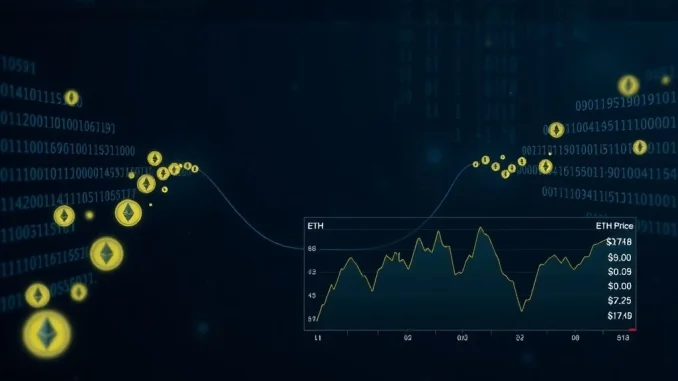
The world of cryptocurrency is always buzzing, and recent Ethereum news has certainly captured attention. If you’ve been following the market, you might have noticed a significant shift: Ethereum’s validator exit queue has soared to an 18-month high, coinciding with a notable dip in ETH price from its July 2025 peak. This isn’t just a fleeting blip; it signals deeper movements within the network’s staking landscape. But what exactly does a surging exit queue mean for the future of Ethereum, and should investors be concerned?
Why is the Ethereum Validator Exit Queue Surging?
The recent surge in Ethereum’s validator exit queue isn’t a simple phenomenon; it’s a complex interplay of market dynamics and strategic shifts. As of July 24, the queue reached a staggering 644,330 ETH, valued at approximately $2.34 billion. This volume has led to an 11-day waiting period for validators to unstake their holdings, the longest such delay in 18 months.
This isn’t the first time we’ve seen such a spike. A similar event occurred in January 2024, which preceded a 15% drop in ETH price. However, experts like staking protocol Everstake suggest this isn’t a sign of panic selling. Instead, it’s often a strategic maneuver by validators.
Several factors contribute to this increased unstaking activity:
- Profit-Taking: After a period of significant gains, some validators are cashing out profits from their staked ETH.
- Strategic Repositioning: Many are unstaking with the intention to re-stake, optimize their operations, or rotate to different operators. This allows them to adapt to changing network conditions or seek better yield opportunities.
- Institutional Movements: Treasury firms such as SharpLink and Bitmine have been accumulating ETH since early June. This prompts institutional holders to unstake and transfer assets for more strategic, often centralized, staking solutions.
- Market Volatility & Liquidity Events: High-profile withdrawals, like Tron founder Justin Sun’s 60,000 ETH pull from Aave, can trigger temporary depegs in tokens like Lido’s stETH. This creates liquidity constraints and can cause “panicked yield farmers” to attempt converting stETH back to ETH, further swelling the exit queue.
While the sheer volume in the exit queue might seem alarming, it’s essential to look at the full picture. The underlying reasons paint a more nuanced portrait of a maturing Ethereum validator ecosystem.
Navigating ETH Price Volatility: What’s Driving the Dip?
The surge in the exit queue has naturally coincided with a retreat in the ETH price. Ether’s value dipped over 7% from its July 2025 peak, settling around $3,643 from a high of $3,844. While this represents a short-term correction, it’s worth noting that ETH remains up over 50% in the past month, indicating strong underlying momentum.
The market reaction to the exit queue is multifaceted:
- Short-Term Sell Pressure: When a large amount of ETH is unstaked, it can increase the immediate supply available on the market, leading to downward price pressure as some holders sell.
- Liquidity Shocks: As mentioned, large withdrawals or depegs of liquid staking derivatives (like stETH) can create temporary instability, amplifying sell-offs as traders seek to de-risk or capitalize on arbitrage opportunities.
- Market Sentiment: Even if the underlying reasons for unstaking are strategic, a large exit queue can be misinterpreted as a sign of weakening confidence, leading to speculative selling.
However, it’s crucial to consider the broader context. Despite the dip, the market isn’t in a freefall. The narrative of panic is often overstated, especially when balanced against the significant inflows into the network.
The Resilient Ethereum Staking Ecosystem: Beyond the Headlines
Despite the headlines about the exit queue, the crypto staking ecosystem on Ethereum remains remarkably robust and continues to grow. This resilience is a testament to the network’s fundamental strength and the increasing institutional adoption.
Consider these key indicators:
- Record Validator Numbers: The number of active validators on Ethereum has hit an all-time high of 1.1 million. This signifies a strong and expanding base of participants securing the network.
- Massive Staked ETH: A staggering 35.7 million ETH, representing nearly 30% of the total supply, is currently staked. This amount is valued at approximately $130 billion, showcasing immense commitment to the network’s security and future.
- Strong Entry Queue: While the exit queue garners attention, the entry queue—where 390,000 ETH (about $1.2 billion) awaits activation—suggests that net unstaking is limited to roughly 255,000 ETH. This indicates a healthy balance of incoming capital offsetting a significant portion of the outgoing. Activation delays, now exceeding six days, are the longest since April 2024, highlighting persistent demand to join the staking pool.
- Institutional Confidence: A major catalyst for renewed confidence has been the U.S. Securities and Exchange Commission’s (SEC) May 2024 ruling that staking does not constitute a securities violation. This clarity has significantly boosted institutional participation. Andy Cronk of Figment noted a more than 100% increase in institutional staking delegations since the decision.
- Spot ETH ETF Inflows: The launch of U.S. spot ETH ETFs has also played a crucial role, attracting $2.5 billion in inflows over just six trading days. This underscores a strong institutional appetite for direct exposure to Ethereum.
These factors paint a picture of an ecosystem that is not only enduring short-term pressures but is also expanding its reach and deepening its foundations, particularly with the growing embrace from traditional finance.
What This Means for the ETH Market: Balancing Supply and Demand
The interplay between the unstaking and entry congestion is crucial for understanding the future trajectory of the ETH market. While the exit queue creates short-term sell pressure, the persistent demand for staking and the significant institutional interest suggest that these pressures may stabilize over time.
As David Shuttleworth of Anagram points out, queue dynamics often balance out. Older stakers may lock in their gains, creating room for newer participants to join the network. This continuous cycle of entry and exit is a sign of a liquid and mature market, rather than a failing one.
Furthermore, the broader ecosystem continues to attract substantial capital:
- DeFi Bridge Inflows: Henrik Andersson of Apollo Capital highlighted $8 billion in DeFi bridge inflows into Ethereum’s mainnet over the past three months. This demonstrates the network’s enduring appeal to both on-chain participants and traditional institutions seeking to engage with decentralized finance.
- Long-Term Growth: Despite the recent dip, ETH’s impressive 50% gain in the past month underscores a bullish long-term sentiment. Analysts will now closely watch whether the accelerating institutional adoption of staking can sustain this demand and offset any profit-taking pressures.
In essence, the current dynamics reflect a healthy market adjusting to significant price movements and growing institutional integration. It’s a period of rebalancing, not retreat.
Conclusion
The recent surge in Ethereum’s validator exit queue and the subsequent ETH price dip have certainly created ripples in the crypto community. While the numbers might seem concerning at first glance, a deeper dive reveals a nuanced picture. This isn’t a widespread panic, but rather a strategic repositioning by many validators, fueled by profit-taking, operational optimization, and significant institutional activity. The robust entry queue, record validator numbers, and substantial institutional inflows, especially post-SEC clarity on staking, underscore the network’s underlying strength and persistent demand. As the ETH market continues to mature, these periods of rebalancing are natural. For investors and enthusiasts, understanding these dynamics is key to navigating the exciting and ever-evolving world of Ethereum.
Frequently Asked Questions (FAQs)
Q1: What is the Ethereum validator exit queue?
A1: The Ethereum validator exit queue is a waiting list for validators who wish to unstake their ETH holdings from the network. When validators decide to stop staking, their ETH doesn’t become immediately available; it enters this queue and is released after a certain processing time.
Q2: Why has the Ethereum validator exit queue hit an 18-month high?
A2: The surge is attributed to several factors, including profit-taking by stakers after significant price rallies, strategic repositioning (re-staking, optimizing operations), and institutional movements for strategic asset management. Large withdrawals by key players can also temporarily exacerbate the queue.
Q3: Does a high exit queue mean the ETH price will crash?
A3: Not necessarily. While a large exit queue can create short-term sell pressure as unstaked ETH becomes available, it doesn’t automatically mean a crash. The article highlights that a significant entry queue and strong institutional demand are balancing these outflows. Many validators are also unstaking to re-stake or optimize, not to abandon the network.
Q4: How does institutional interest affect Ethereum’s staking ecosystem?
A4: Institutional interest significantly bolsters the staking ecosystem. Firms are increasingly accumulating and strategically staking ETH, driven by factors like the U.S. SEC’s ruling that staking is not a securities violation. This increased institutional participation adds stability and long-term demand for staked ETH.
Q5: What is the current state of staked ETH on the network?
A5: Despite the exit queue, Ethereum’s staking ecosystem is thriving. There are over 1.1 million active validators, with 35.7 million ETH (nearly 30% of the total supply) currently staked, valued at approximately $130 billion. This indicates strong confidence and commitment to the network’s security.
Q6: What is the significance of the entry queue?
A6: The entry queue, where new ETH awaits activation for staking, is crucial. It shows persistent demand to join the network’s security mechanism. A large entry queue, even with a large exit queue, indicates a healthy balance of incoming capital, suggesting that net unstaking is limited and confidence in staking remains high.



